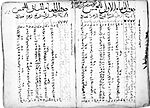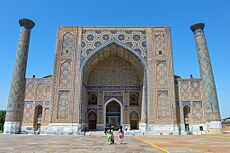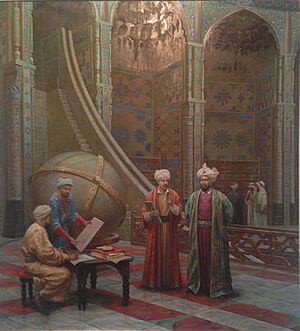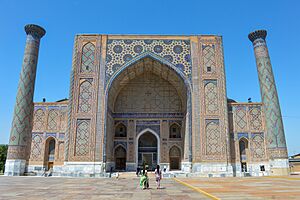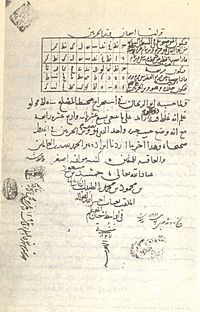Timurid Renaissance facts for kids
| Date | 14th century - 16th century |
|---|---|
| Location | Timurid Empire (Central Asia and Persia) |
| Participants | Timurid dynasty |
The Timurid Renaissance was a special time in Asian and Islamic history. It happened from the late 1300s to the early 1500s. After a period when Islamic culture was not as strong, the Timurid Empire brought back a lot of art and science. This empire was based in Central Asia and ruled by the Timurid dynasty.
The word renaissance comes from French and means "rebirth." It describes a time when culture becomes strong again. This "rebirth" in the Timurid Empire happened a bit before the famous Renaissance in Europe. Some people even say it was as amazing as the Italian Renaissance. The Timurid Renaissance was at its best in the 1400s, after the Mongol invasions and conquests had ended.
This exciting period was built on Islamic ideas. It included the rebuilding of Samarkand and the invention of Tamerlane Chess by Timur. It also saw the rule of Shah Rukh and his wife Gawhar Shad in Herat. Herat became a cultural center, much like Florence in Italy. The time of the astronomer and mathematician Ulugh Begh was also very important. Many smart people, called polymaths (people good at many subjects), lived then. The art-loving ruler Sultan Husayn Bayqara built even more learning centers.
During Timur's rule, people became very interested in classical Persian art again. Huge building projects started. They built mausoleums (tombs), madrasas (schools), and kitabhane (workshops for making books). Studies in math and astronomy became popular once more. By the early 1500s, people in the empire also became very skilled with firearms.
Some of Timur's biggest projects were the Summer Palace in Shahrisabz, the Bibi-Khanym Mosque, and the Registan. The city of Herat became a major center for thinkers and artists in the Muslim world. Samarkand had been destroyed by the Mongols earlier. But during this time, it was rebuilt and became a main center for the Renaissance and Islamic civilization.
The Timurid Renaissance was different from earlier cultural times. It didn't just copy old styles. Instead, it made art and culture more popular by using everyday styles in the Persian language. The ideas from the Timurid Renaissance later influenced Mughal India. It also had a big impact on other powerful states like Ottoman Turkey and Safavid Iran.
Contents
A Time of New Ideas

The Timurid Empire was started by Amir Tamerlane in 1370. He conquered many areas that used to be part of the Ilkhanate. After taking over a city, the Timurids often saved the lives of local artists and craftspeople. They would then move them to the Timurid capital, Samarkand.
When the Timurids conquered Persia in the early 1400s, many Islamic art styles mixed with existing Mongol art. Later in his life, Timur made Islamic Sharia law important. This helped make Samarkand a key center for Islamic art.
In the mid-1400s, the empire moved its capital to Herat. This city then became a main spot for Timurid art. Like Samarkand, Herat soon had many artists and thinkers from different backgrounds. They made Herat a hub for arts and culture. Soon, many Timurid cultural styles blended with those from other traditions.
Amazing Art and Buildings
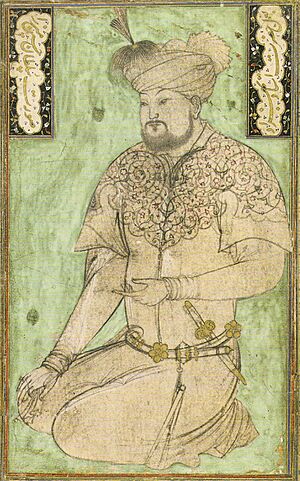
Timurid art took the traditional Persian idea of "Arts of the Book" and made it even better. Artists in the empire created beautiful illustrated books using paper, not parchment. These pictures were known for their bright colors and fancy designs. An art historian named Suzan Yalman said that the art from Herat is often seen as the best of Persian painting.
Timurid steel, often decorated with silver inlaid designs, was also very high quality. Painting wasn't just for books. Many Timurid artists also made detailed wall paintings. These paintings often showed landscapes from both Persian and Chinese art. Even though the ideas came from other cultures, Timurid wall paintings developed their own special style.
Some Mongol art styles stayed popular. For example, the way human figures were drawn in Timurid art in the 1400s came from Mongol culture.
The rule of Sultan Husayn Bayqara saw art become even more popular. He was known for supporting learning and the arts in his kingdom. Sultan Husayn built many structures, including a famous school. He was seen as a perfect Timurid ruler of his time. His fancy court and generous support for artists were admired by many, including his cousin, Babur of Mughal India.
Grand Timurid Architecture
Timurid architecture used ideas from Seljuk architecture. Buildings were decorated with turquoise and blue tiles. These tiles formed complex lines and geometric shapes on the outside. Sometimes, the inside of buildings was decorated in a similar way. Paintings and stucco reliefs made them even more beautiful.
Timurid architecture was a top example of Islamic art in Central Asia. Timur and the rulers after him built amazing and grand buildings in Samarkand and Herat. These huge works helped spread the influence of this art style all the way to India. There, it led to the famous Mughal school of architecture.
Timurid architecture started with the sanctuary of Ahmed Yasawi in modern-day Kazakhstan. It reached its peak with Timur's own tomb, Gur-e Amir in Samarkand. Timur's tomb, built in the 1300s, is covered with "turquoise Persian tiles." Nearby, in the old city center, there is a "Persian style madrassa" (religious school) and a "Persian style mosque." These were built by the Timurid Sultan Ulugh Beg. The tombs of Timurid princes, with their turquoise and blue-tiled domes, are still some of the most beautiful Persian architecture.
A key feature of all major Timurid buildings is Axial symmetry (meaning they are the same on both sides). You can see this in the Shāh-e Zenda in Samarkand, the Musallah complex in Herat, and the mosque of Gawhar Shad in Mashhad. Many buildings had double domes of different shapes, shining with bright colors on the outside. Timur's power in the region made his capital and Persian architecture very influential in the Indian Subcontinent.
Metalwork, Pottery, and Carving
The Timurid Empire also made high-quality metalwork. They often used Steel, iron, brass, and bronze. Timurid steel, decorated with silver inlaid designs, is often said to be especially good. After the Timurid Empire declined, other cultures in Iran and Mesopotamia adopted Timurid metalwork styles.
Timurid artists also made ceramics that looked like Chinese styles. Jade carving was another art form found in Timurid art.
Smart Scientists and Discoveries
Jamshid al-Kashi was a very important person in math and astronomy. He received a lot of support from both Emperor Shah Rukh and Queen Goharshad. They were very interested in science and encouraged their court to study many different fields deeply. Because of this, their time in power saw many great scholarly achievements.
The rule of Sultan Ulugh Begh was the peak of science in the empire. During his time, al-Kashi created sine tables that were very accurate. He also made tables for changing between different coordinate systems used to map the sky.
A book called Sullam al-Sama was written. It helped solve problems that earlier scientists had with figuring out the distances and sizes of heavenly bodies. These included the Earth, the Moon, the Sun, and the Stars. Another book, Treatise on Astronomical Observational Instruments, described many different tools. These included the triquetrum and armillary sphere, and the sextant of al-Khujandi. It also described a special double quadrant Azimuth-altitude tool he invented.
They also invented the Plate of Conjunctions. This was like an analog computer used to find out when planets would line up. Another invention was a mechanical planetary computer called the Plate of Zones. This tool could solve many planet-related problems. It could predict the true positions of the Sun and Moon, and the planets in their elliptical orbits.
Ulugh Begh started a school in Samarkand that quickly became a famous university. Students from all over Central Asia came to this academy. Because of this, Ulugh Beg brought together many great mathematicians and scientists, including Ali Qushji.
Ali Qushji made big advances in astronomical physics. He showed that astronomy did not have to depend on natural philosophy. He also found empirical evidence (evidence from observation) that the Earth spins. He wrote about this in his work, Concerning the Supposed Dependence of Astronomy upon Philosophy. Ali Qushji also helped with Ulugh Beg's famous work, Zij-i-Sultani. He helped start the Sahn-ı Seman Medrese, one of the first centers for Islamic sciences in the Ottoman Empire.
Qushji's most important astronomy work was about how astronomy didn't need to rely on philosophy. He disagreed with Aristotelian physics (old Greek ideas about how the world works). He separated natural philosophy from Islamic astronomy. This allowed astronomy to become a science based purely on observation and math. This let him think about ideas like a moving Earth, instead of just a stationary one. He found evidence from observing comets that the idea of a moving Earth was just as likely as a stationary Earth.
What Came Next
After the Timurid Empire became weaker in the late 1400s, other powerful empires took over. These were the Gunpowder empires: the Ottomans, the Safavid dynasty, and Mughal India. They all used and built upon the artistic traditions of the Timurids.
See also
- Timurid art
- Turco-Persian tradition
- Timurid relations with Europe
- Timeline of Samarkand



